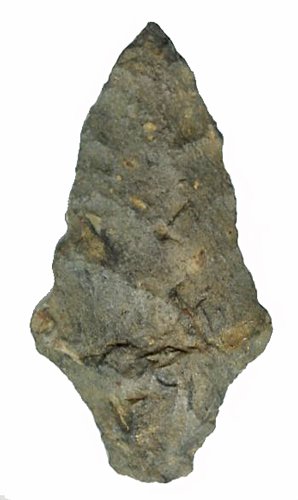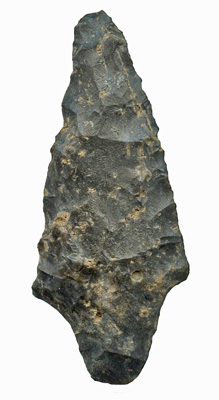



Point Type: STARK
Also See: Gypsum Cave Straight Stemmed,
Lagoon, Morrow Mountain, Neville , Piscataway, Poplar Island, Rossville
Location: New Jersey Northward to Southern New England
Associated Dates: 7000 - 6000 B.P.
- Middle Archaic - Late Archaic
Morphology: Stemmed
General Description: The Stark dart point is a small to medium sized
narrow, contracting stemmed point with tapering shoulders and a
rounded to pointed stem which can be stubby. The shoulders are
the widest part of the triangular shaped blade. The shoulders are well defined
and angled away from the stem. The stem is small and is tapered on
almost all specimens. The base is pointed on the majority
of specimens however it can be straight or concave or oblique as
variants. The basal irregularity should be checked as broken or
damaged bases can be the cause. The blade edges are convex and
the majority of speicimens but straight and irregular edges are
common. The stem edges are ground.
The size range for
the Stark point ranges from 37 mm to 70 mm in length.
The point was
manufactured from metamophosed siltstone, felsites, rhyolite, chert, quartz and quartzite.
The Stark is part of the
Morrow Mountain complex according to
Justice.
The Stark was named by Dena F. Dincauze in 1976 for
Archibald and John Stark, the early settlers who owned the property of the
Neville site in Amoskeg, Manchester, New
Hampshire.
About The Point Pictured Above (Left - shown twice size): The point pictured above on the left hand side of the page, is a smaller sized Stark point made from a dark gray and brown siltstone. The point is hightly patinated and the base is chipped giving a truncated basal outline. The point measures 46 mm in length, 24 mm at the widest point (the shoulders) and is 7.2 mm thick at its thickest point (mid blade at the shoulders) with the typical thickness along the blade being 5.1 mm. The edges of the stem are ground with the exception of the fracture in the base tip. The point has an interesting feature... the hafting area is thicker than the blade and perhaps the blade was resharpened with the base mounted in the dart bindings leaving the base protected from rework. This point was a surface find from cornfields in the historic Robert Treat Farm, Borough of Woodmont, Milford, Connecticut. Catalog Number 193-12-C
About The Point Pictured Above (Right - shown twice size): The point pictured above on the right hand side of the page, is a medium sized Stark point made from a dark blackish Normanskill chert which has many small tan inclusions and eroded voids. The point is hightly patinated and the tip is chipped off historically. The point measures 56 mm in length, 24 mm at the widest point (the shoulders) and is 9.1 mm thick at its thickest point (mid blade at the shoulders) with the typical thickness along the blade being 7.1 mm. The point has a uni-sided median ridge which accounts for the thickness. The edges of the stem are ground. This point was a surface find from the old Forbes Farm on the Connecticut River in East Hartford, Connecticut. Catalog Number 426-11-C
References: Boudreau, Fogelman, Hranicky (1, 2), Justice (1)
© Copyright 1997 - 2009 LITHICS-Net WWW.LITHICSNET.COM
Use your Browser's BACK Button to return to the LITHICS-Net Index.